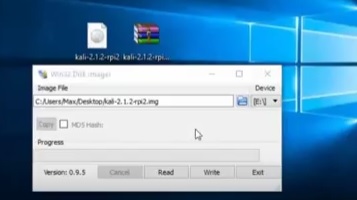
- Kali linux on raspberry pi android#
- Kali linux on raspberry pi pro#
- Kali linux on raspberry pi download#
Kali linux on raspberry pi download#
If you want the extras that come from using the "Sticky Fingers" build, you can download that image from the Whitedome website. In testing, I found the "Sticky Fingers" build had a few issues, so for now, I'd recommend going with the official Kali version for a guaranteed stable build. There are two places we can get this disk image: the official Kali website or from the Whitedome website for the "Sticky Fingers" Kali build that includes some useful modifications. The first step will be to determine which disk image you want to use for the Pi 4 Model B and download it so that you can burn it to the microSD card. On Amazon: CanaKit Raspberry Pi 4 Starter Kit with 32 GB MicroSD, Official Case, Power Supply & More After the initial setup, you should be able to access the Pi without a keyboard or mouse by logging in over a network with SSH. The twin Micro-HDMI ports on the Pi 4 Model B are really tiny and can easily be confused with Micro-USB cables, but the two are not compatible.Īs with the other models of Raspberry Pi, you'll need to supply a micro SD card, card reader, keyboard, and mouse, as well as a monitor of some sort to get started working with the Pi.
Kali linux on raspberry pi pro#
Plugging an unsupported smart charging cable, like a Macbook Pro USB-C cable, won't be able to power the Pi 4 Model B.Īside from a supported USB-C cable, you'll also need a Micro-HDMI adapter. Thanks to the omission of a resistor, the new Pi 4 Model B can't be used with "smart" charging cables that can adjust themselves to the voltage of anything they are plugged into. You'll also need some accessories to power and interact with the board, starting with a compatible USB Type-C adapter.Īfter the release of the Pi 4 Model B, it became clear that the specification for the USB-C standard had not been followed. To get started, you'll need one of the new Raspberry Pi 4 Model B options. Rather than using the familiar airmon-ng start command, we'll be using a new command to add the network card as a device in monitor mode manually.

While the internal network adapter is capable of doing all the things we want it to do, the process for putting it into monitor mode is a little different from the previous Raspberry Pi. The increase in speed and power of the Pi 4 Model B make it a more capable networking device as well as a more capable computer. That means it's possible to do things like grab WPA handshakes, listen in on Wi-Fi traffic, and execute attacks like WPS-Pixie without needing a separate compatible Wi-Fi network adapter.įor someone interested in getting started with Wi-Fi hacking, the Raspberry Pi 4 Model B provides a Kali-supported Wi-Fi network adapter and an onboard computer capable of basic cracking and MiTM attacks in a single package. The addition makes it possible to put the built-in Wi-Fi network adapter into monitor mode.


One of the most exciting things about using a Raspberry Pi for hacking is the add-on of the Nexmon firmware. If your smartphone can't create a hotspot, the Pi can also host its own Wi-Fi network, allowing you to join the network created by the Pi on your phone and SSH into it on the go. If your smartphone supports creating a Wi-Fi hotspot, it's simple to connect the Pi to your hotspot and control it over SSH.

Kali linux on raspberry pi android#
Plus, it's sometimes more straightforward to run Kali on hardware rather than in a virtual machine.Īnother advantage to the Raspberry Pi is that it can easily be used in combination with a device like an unmodified iPhone or Android smartphone. Virtual machines can behave unpredictably, especially when working with Wi-Fi hacking. Previous Raspberry Pi versions have proved that it doesn't take expensive hardware to run tools in Kali Linux. The reasons for using a Raspberry Pi as a hacking computer are many. Thanks to the number of Wi-Fi hacking tools included in Kali Linux, the new Pi 4 Model B represents a complete Ethernet and Wi-Fi hacking kit for beginners. It also includes support for Wi-Fi hacking on its internal wireless card.įor hackers interested in a cheap Kali Linux computer capable of hacking Wi-Fi without a separate wireless network adapter, the Pi 4 Model B is a great way to run Kali without needing a virtual machine. Performance and hardware changes aside, the Pi 4 Model B runs Kali Linux just as well, if not better, than its predecessors. In 2019, the Raspberry Pi 4 was released with specs including either 1 GB, 2 GB, or 4 GB of memory, a Broadcom BCM2711B0 quad-core A72 SoC, a USB Type-C power supply, and dual Micro-HDMI outputs.


 0 kommentar(er)
0 kommentar(er)
